The bathhouse is one of the first structures that appear after the completion of the construction of a house or summer cottage. A do-it-yourself stove for a bath with a water tank is a multifunctional device that increases the comfort of the procedure and allows you to save on the purchase of expensive factory products. When manufacturing, it is important to comply with fire safety requirements, to make a trauma-safe and economical device.
Requirements for the installation of a sauna stove
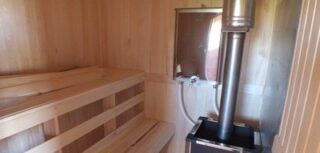
Stoves and chimneys near sauna stoves are heated to temperatures of 200 ° C and higher, and therefore pose an increased danger:
- High temperatures can ignite floors, walls and ceilings made of combustible materials.
- All surfaces can cause severe burns if handled carelessly.
- Burning wood produces hazardous gases that must be removed into the chimney.
The danger is eliminated by the correct choice of the design of the stove and chimney, high-quality thermal insulation of surfaces, and the right choice of location.
The operating rules are described in detail in the guidelines: Fire Safety Rules, SNiP 41-01-2003 Heating, Ventilation and Air Conditioning, GOST 53321-2009 Heat-generating devices operating on various types of fuel.
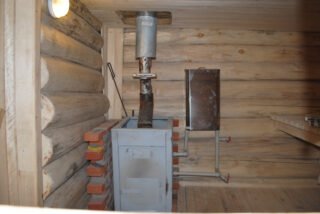
Primary requirements:
- Adjoining surfaces made of combustible materials should not be heated above 45 ° C. To do this, choose a distance from the stove to the walls and ceiling of at least 50 cm or use heat-insulating screens.
- The protective screen under the oven should be no thinner than 5 cm and covered with a steel sheet of 1 mm and thicker. The protection should protrude 10 cm outside the stove, including 50 cm from the side of the firebox.
- The distance from the combustible ceiling for the stove is more than 1 meter and at least 80 cm if the materials are not burning.
- The chimney should not have more than 3 turns at an angle greater than 30 °.
- The maximum length of the horizontal section of the chimney is no more than 1 meter.
- If the roof is combustible, then the top of the pipe is equipped with a spark arrester head with holes from 1 to 5 mm.
- When passing through wooden structures, metal cuts are arranged with a diameter of at least 50 cm.
- The minimum diameter of the chimney pipe is calculated according to the formula D pipe in mm = volume of the combustion chamber in liters x 1.27.
- The firebox is turned towards the exit from the steam room or the fuel is put in from the side of the dressing room.
To prevent burns, metal ovens are shielded to prevent accidental touching.
Operation of furnaces with tanks
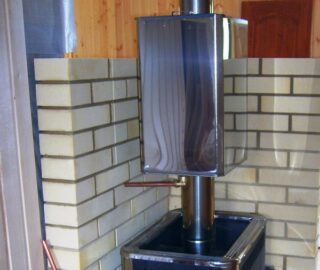
There are two principles of operation of stoves in a bath with a water tank:
- direct heating in a container, which can be external or built into the oven - boiling water is taken from the tank;
- circulation of water between the heat exchanger and the external storage tank, the movement of liquid through the connecting pipelines is carried out by gravity or by means of a circulation pump.
Circulation systems in their own are divided into two types: with direct and indirect heating. In both cases, the energy of the burning fuel is used.In the direct method, the water in the tank or heat exchanger is heated directly by fire, from the heated walls of the furnace or from a chimney that removes hot combustion products.
When using, it is necessary to take into account the physical properties of the materials of the system and water:
- the tank is poured before the furnace is kindled, leaving a margin necessary to compensate for the expansion of the liquid;
- do not pour cold water into an empty heated tank - the metal can burst, and the sharply released steam can cause burns;
- it is necessary to provide a backup power supply for the circulation pump - if, during a power outage, the circulation stops and the heat exchanger may explode from the rising pressure.
In the case of systems of an indirect principle of operation, heat transfer is used due to an intermediate heat carrier:
- A spiral or a container with a heat carrier is installed in the heat exchanger of the furnace.
- The heated tank and the storage tank are connected by pipelines.
- The heated intermediate heat carrier is moved by the pump along the circuit, heating up and then giving off heat.
- The surface of the spiral in the storage tank is heated by the intermediate heat carrier, giving off heat to the consumed water.
Use antifreeze as a coolant. In this case, the pipeline will not defrost at temperatures up to minus 40 degrees, which is convenient for rarely visited summer cottages and free-standing baths.
Indirect systems are more complex in the device, but more stable in operation.
Varieties of designs
There are many designs that allow you to heat water when heating a furnace in a bath.
Mounted and attached
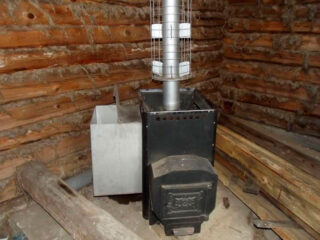
Heating is done from the hot walls of the furnace.
Such designs are easy to use. They are distinguished by:
- mobility - the tank can be taken out of the steam room and rinsed with a water supply;
- versatility - the ability to install from any side, which is important for small steam rooms;
- variability of fastening, devices are suspended on hooks, placed on the upper surface, installed on the floor or on a stand;
- relatively low price, comparable to the price of a conventional metal container;
- after heating to the required temperature, the tank can be removed from the stove, then all the energy will be spent on heating the air in the steam room;
- in the event of a leak, the container can be easily repaired, since the device is mobile.
There are drawbacks to mounted and attached tanks. Physical processes at the heating boundary lead to the appearance of scale or sediment on the tank wall, which impairs thermal conductivity and increases the heating time.
Dross is actively formed on the furnace wall, which reduces the durability of the structure and also reduces thermal conductivity.
For brick ovens, hinged and attached structures are not suitable, since the temperature of the walls is low and the water in the tank will not warm up.
A do-it-yourself steam room stove is often used with hinged tanks.
Built-in
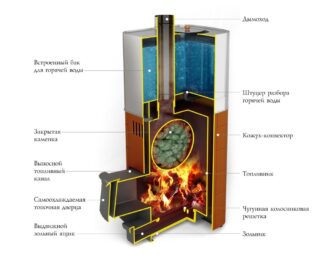
Homemade metal bath stoves with built-in tanks are difficult to manufacture. It takes professional skills of a welder to make a sealed structure.
The peculiarity of the built-in equipment is that it cannot be removed. This makes it difficult to operate.
A positive property is to keep the water hot even after the fuel has ceased to be added - the stove itself remains hot for a long time. At the same time, as it warms up, the water remains in the tank and can boil, which is inconvenient for use - you have to dilute it to the desired temperature.
Part of the heat is always spent on heating the water, not the air in the steam room.
Chimney
To heat water in such furnaces, the energy of combustion products is used. The gases passing through the chimney heat its walls, giving off heat to the water.
There are heat exchangers on sale that can be put on a standard chimney or made as a separate elbow for standard pipes.
Both direct and indirect heating devices are used. The second option is often made in the form of a coil.Through it, you can run directly service water or an intermediate heat carrier in indirect heating systems.
The advantages of the method:
- use of waste gas energy;
- small size - devices do not take up useful space;
- it can be installed outside the steam room and used as a water source for a shower.
The main disadvantage is the mandatory presence of a storage tank due to the small size of the chimney heat exchanger. Otherwise, the water will quickly boil and evaporate.
If you make a chimney nozzle of a large size, the pipe will give too much heat to the water. A decrease in the chimney temperature leads to a deterioration in draft and the formation of soot on the inner walls of the chimney.
Device Specifications
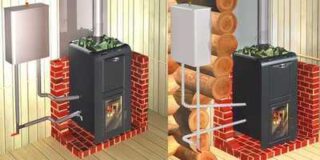
Two characteristics are important for operation: system capacity and performance.
When making a simple stove for a bath, you need to know that 1 m² of a heat exchanger, which is exposed to an open fire, is able to “take away” a power equal to 10 kW from the stove.
On average, a home-made stove produces 6-7 kW of heat; you cannot make the heat exchanger too bulky. There is a risk that most of the energy of the burned fuel will be spent on heating the water, not the steam room air.
It is known from practice that for the entire complex of paired procedures, one person needs about 10 liters of water at room temperature or about 5 liters of liquid heated to 80 ° C. Based on this volume, water heating systems are made.
Metal sauna stove
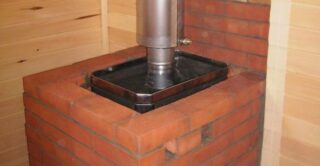
To cook a stove for a bath with your own hands from metal according to drawings is the easiest way to save on equipment for a steam room. They think over the design on their own or adapt the dimensions to detailed drawings that are easy to find on the Internet. They make options with mounted or built-in tanks, it all depends on the qualifications and skills of the owner in welding.
Iron stove designs are similar and consist of the following basic elements:
- fireboxes with doors for storing firewood and a blower, grate;
- heaters - places where heat accumulating stones will be laid;
- water tank, heat exchanger in spaced-apart systems.
To speed up the work, tools and materials are prepared in advance.
Of the tools for work you will need:
- welding machine, mask, electrodes;
- angle grinder (grinder) with cutting and grinding wheels, drill with a set of drills;
- tape measure or meter, steel corner template;
- pencil or scribe for marking.
The work is simplified if a corner equipped with magnets is present in the master's arsenal - the accuracy of the work becomes higher, one hand is released, since the workpieces are reliably connected at the right angle before tacking.
The material for the furnace is purchased at construction sites, but it is more profitable to visit the metal acceptance points - there you can always find the blanks necessary in size.
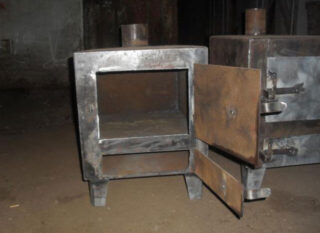
You will need:
- steel sheet from 3 mm for the walls and bottom of the furnace, water tank;
- iron sheet from 8 mm for the top cover (bottom of the tank);
- cast iron grate or steel reinforcement with a diameter of 16 mm, if thinner, then it will quickly lead;
- pipe from 100 mm for the chimney;
- tap for draining water from the tank;
- steel sheet for floor protection;
- ready cut for the pipe.
To make the stove beautiful, you can purchase forged curly products that are welded to the outer walls.
Cast iron doors are not suitable for steel stoves, since it will not work to weld two metals at home.
Manufacturing sequence
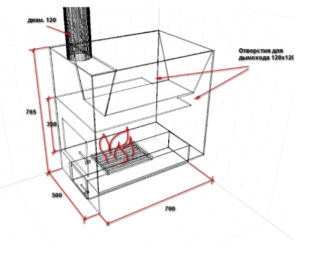
A drawing of a metal sauna stove with exact dimensions can be adapted to your own needs. It is enough to proportionally reduce or increase the size of each part.
Algorithm for making a furnace with a built-in tank:
- The metal is marked out according to the required dimensions.For marking, use homemade steel wire scribes or purchased taps.
- The cuts are carried out with a grinder, the edges are cleaned.
- They make a case, pay attention to the tightness of the seams - the leaking carbon monoxide is poisonous, and the smoke makes being in the steam room unpleasant. The lid is not made.
- Holders for the grate are welded, if necessary, steel plates are welded between the firebox and the blower to reduce the gaps into which large unburned pieces of fuel fall.
- The tank is made. The bottom must be made of steel with a thickness of 8 mm so that it does not burn out quickly. The size must match the dimensions of the oven cover. Check the tightness of the seams, if necessary, weld the detected leak.
- The tank is welded in place of the upper cover of the furnace body.
- Cut out the doors of the firebox and blower. They are welded to the body on the hinges.
- The chimney pipe is led out through the back wall. You can apply the scheme when the pipe is passed inside the water tank. This requires cutting a hole in thick metal, which is not easy.
- Install the stove in place and connect the chimney. A meter section from the furnace is made from a pipe with a wall thickness of 3.5 mm. Thin metal is red-hot and burns out quickly.
- Carry out a test furnace, eliminate smoke leaks.
If the test firebox is successful, use the stove normally.
Building a brick oven for a wood-fired sauna with your own hands
For self-construction of a brick oven, it is worth objectively assessing your skills in masonry work.
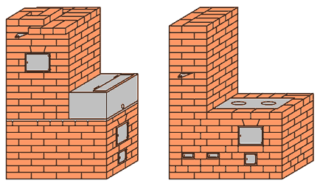
From the drawings and procedures available on the Internet, they choose the simplest stove for a bath.
You will need:
- shovel and container for mixing the solution;
- trowel or trowel;
- plumb line and level;
- tool for welding a metal water tank;
For the inner walls, refractory bricks are purchased for the outer ones, a red corpulent ordinary. It is advisable to use a ready-made commercial mixture for masonry, since only experienced stove-makers can independently choose a composition of clay, sand and cement.
They buy in advance cast iron grates, firebox and blower doors, a set of valves for a pipe.
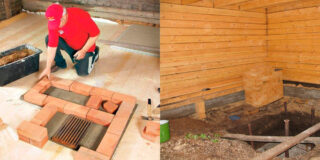
Work algorithm:
- Prepare a foundation with a thickness of 25 cm, it is necessary to provide for a protrusion of the foundation beyond the walls by at least 25 cm.
- Focusing on the order and description, they lay the walls of the furnace.
- The doors are mounted during masonry, the frames will be non-removable.
- A water tank is made according to the required dimensions.
- Mount the tank and continue to lay out the stove, and then the chimney.
- It is important to respect the proportions of the masonry mixture and not to make the seam thicker than a few millimeters.
- A test furnace is carried out after 5–7 days, when the solution hardens.
- If no smoke leaks are found, the walls of the stove and the chimney are plastered.
Making a sauna stove with a tank is not difficult, but it requires great care. Using the device is simple and comfortable if the design is correctly selected. It is important to follow the recommendations and the stove will serve for many years.








